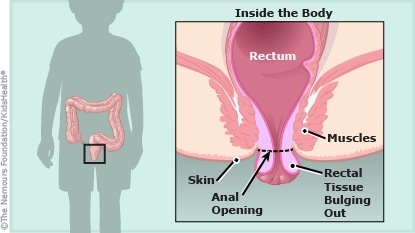After Rectal Prolapse: How to Care for Your Child
A rectal prolapse happens when the lining of the rectum bulges out from the anus. Rectal prolapse can happen more than once, but most kids do well with treatment and stop having episodes of rectal prolapse as they get older.


A rectal prolapse sometimes happens after a child poops or strains. A clump of red or pink tissue bulges out of the anus. It usually moves back into the body on its own.
Rectal prolapse can happen in babies and young children with constipation and frequent straining, but also can be due to diarrhea, certain infections, weak muscles in and around the anus, and other health conditions.
Your child's rectal prolapse is now better. If it did not go back into the body or get better on its own, the health care provider may have needed to gently push it back in with gloved fingers. If needed, the health care provider gave medications to make your child comfortable or sleepy while pushing it in. A dressing may have been taped over the anus to help the rectal tissue stay in place. The health care provider also might have done some tests to find out what caused the prolapse.
To prevent a rectal prolapse from happening again, your health care provider will treat the underlying cause. For example, if your child has constipation, the health care provider might recommend a high-fiber diet, plenty of water, and regular exercise or possibly a stool softener.
If rectal prolapse continues to happen, parents and older kids can learn how to push it back in at home. If prolapse continues to happen even with treatment, is painful, or causes complications, surgery may be needed.

-
Give your child any prescribed medicine or fiber supplements as directed.
-
Encourage good toilet habits. Your child should:
-
Try different positions when sitting on the toilet to avoid straining.
-
Avoid sitting on the toilet for more than a minute or two. Instead, have your child get off of the toilet and try to poop later when the urge is stronger.
-
Go to the bathroom immediately when he or she has the urge to have a bowel movement.
-
Do not give your child laxatives unless the instructed to do so.
-
If your child has a dressing, remove it as instructed.
-
Check for a prolapse after your child poops or strains.
-
If your child has another prolapse and the health care provider has taught you how, follow the instructions for gently pushing it back into place.
-
Make sure your child drinks enough water every day and follows the diet instructions.


Your child:
-
Has belly pain or vomiting.
-
Has pain in the anus.
-
Has blood on the toilet tissue or in the toilet water for more than 2 days.
-
Had previously been toilet trained and begins having poop accidents.
-
Has another rectal prolapse.

Your child has: